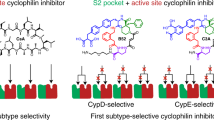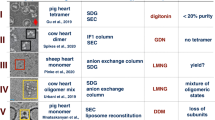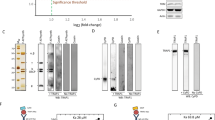Abstract
Aim:
To investigate methods for identifying specific cyclophilin D (CypD) inhibitors derived from quinoxaline, thus developing possible lead compounds to inhibit mitochondrial permeability transition (MPT) pore opening.
Methods:
Kinetic analysis of the CypD/inhibitor interaction was quantitatively performed by using surface plasmon resonance (SPR) and fluorescence titration (FT) techniques. IC50 values of these inhibitors were determined by PPIase inhibition activity assays.
Results:
All the equilibrium dissociation constants (KD) of the seven compounds binding to CypD were below 10 μmol/L. The IC50 values were all consistent with the SPR and FT results. Compounds GW2, 5, 6, and 7 had high inhibition activities against Ca2+-dependent rat liver mitochondrial swelling and Ca2+ uptake/release. Compound GW5 had binding selectivity for CypD over CypA.
Conclusion:
The agreement between the measured IC50 values and the results of SPR and FT suggests that these methods are appropriate and powerful methods for identifying CypD inhibitors. The compounds we screened using these methods (GW1-7) are reasonable CypD inhibitors. Its potent ability to inhibit mitochondrial swelling and the binding selectivity of GW5 indicates that GW5 could potentially be used for inhibiting MPT pore opening.
Similar content being viewed by others
Article PDF
References
Liu X, Kim CN, Yang J, Jemmerson R, Wang X . Induction of apoptotic program in cell-free extracts: requirement for dATP and cytochrome c. Cell 1996; 86: 147–57.
Susin SA, Lorenzon HK, Zamzami N, Marzo I, Snow BE, Brothers GM, et al. Molecular characterization of mitochondrial apoptosis-inducing factor. Nature 1999; 397: 441–6.
Olson M, Kornbluth S . Mitochondria in apoptosis and human disease. Curr Mol Med 2001; 1: 91–122.
Crompton M . Mitochondria and aging: a role for the permeability transition? Aging Cell 2004; 3: 3–6.
Waldmeier PC, Zimmermann K, Qian T, Tintelnot-Blomley M, Lemasters JJ . Cyclophilin D as a drug target. Curr Med Chem 2003; 10: 1485–506.
Mattson MP, Kroemer G . Mitochondria in cell death: novel targets for neuroprotection and cardioprotection. Trends Mol Med 2003; 9: 196–205.
Sullivan PG, Rabchevsky AG, Waldmeier PC, Springer JE . Mitochondrial permeability transition in CNS trauma: cause or effect of neuronal cell death? J Neurosci Res 2005; 79: 231–9.
Crompton M . On the involvement of mitochondrial intermembrane junctional complexes in apoptosis. Curr Med Chem 2003; 10: 1473–84.
Connern CP, Halestrap AP . Purification and N-terminal sequencing of peptidyl-prolyl cis-trans-isomerase from rat liver mitochondrial matrix reveals the existence of a distinct mitochondrial cyclophilin. Biochem J 1992; 284: 381–5.
Fischer G, Wittmann-Liebold B, Lang K, Kiefhaber T, Schmid FX . Cyclophilin and peptidyl-prolyl cis-trans isomerase are probably identical proteins. Nature 1989; 337: 476–8.
Lin DT, Lechleiter JD . Mitochondrial targeted cyclophilin D protects cells from cell death by peptidyl prolyl isomerization. J Biol Chem 2002; 277: 31134–41.
Li Y, Johnson N, Capano M, Edwards M, Crompton M . Cyclophilin-D promotes the mitochondrial permeability transition but has opposite effects on apoptosis and necrosis. Biochem J 2004; 383: 101–9.
Schubert A, Grimm S . Cyclophilin D, a component of the permeability transition-pore, is an apoptosis repressor. Cancer Res 2004; 64: 85–93.
Machida K, Osada H . Molecular interaction between cyclophilin D and adenine nucleotide translocase in cytochrome c release: does it determine whether cytochrome c release is dependent on permeability transition or not? Ann NY Acad Sci 2003; 1010: 182–5.
Crompton M . The mitochondrial permeability transition pore and its role in cell death. Biochem J 1999; 341: 233–49.
Halestrap AP, McStay GP, Clarke SJ . The permeability transition pore complex: another view. Biochimie 2002; 84: 153–66.
Crompton M, Costi A . Kinetic evidence for a heart mitochondrial pore activated by Ca2+, inorganic phosphate and oxidative stress. A potential mechanism for mitochondrial dysfunction during cellular Ca2+ overload. Eur J Biochem 1988; 178: 489–501.
Crompton M, Barksby E, Johnson N, Capono M . Mitochondrial intermembrane junctional complexes and their involvement in cell death. Biochimie 2002; 84: 143–52.
Alaimo RJ [ inventor]. Norwich Eaton Pharmaceuticals [assignee]. Thiocyanatoquinoxaline compounds with immunomodulating activity. US patent 4540693. September 10, 1985.
Magnus P, Thurston LS . Synthesis of the vinblastine-like antitumor bis-indole alkaloid navelbine analogue desethyldihydronavelbine. J Org Chem 1991; 56: 1166–70.
Sambrook J, Fritsch EF, Maniatis T . Molecular Cloning: A Laboratory Manual. 2nd ed. New York: Cold Spring Harbor Laboratory Press; 1989.
Luo C, Luo H, Zheng S, Gui C, Yue L, Yu C, et al. Nucleocapsid protein of SARS coronavirus tightly binds to human cyclophilin A. Biochem Biophys Res Commun 2004; 321: 557–65.
Husi H, Zurini MGM . Comparative binding studies of cyclophilins to cyclosporin A and derivatives by fluorescence measurement. Anal Biochem 1994; 222: 251–5.
Handschumacher RE, Harding MW, Rice J, Drugge RJ . Cyclophilin A: a specific cytosolic binding protein for cyclosporin A. Science 1984; 226: 544–7.
Kofron JL, Kuzmic P, Kishore V, Colon-Bonilla E, Rich DH . Determination of kinetic constants for peptidyl prolyl cis-trans isomerases by an improved spectrophotometric assay. Biochemistry 1991; 30: 6127–34.
Blattner JR, He L, Lemasters JJ . Screening assays for the mitochondrial permeability transition using a fluorescence multiwell plate reader. Anal Biochem 2001; 295: 220–6.
Lowry OH, Rosenbrough NH, Farr AL, Randall JR . Protein measurement with the folin phenol reagent. J Biol Chem 1951; 193: 265–75.
Thompson J, Higgins D, Gibson T . CLUSTAL_W: improving the sensitivity of progressive multiple sequence alignment through sequence weighting, position-specific gap penalties and weight matrix choice. Nucleic Acids Res 1994; 22: 4673–80.
Gamble T, Vajdos F, Yoo S, Worthylake D, Houseweart M, Sundquist WI, et al. Crystal structure of human cyclophilin a bound to the amino-terminal domain of HIV-1 capsid. Cell 1996; 87: 1285–94.
Vajdos F, Yoo S, Houseweart M, Sundquist W, Hill C . Crystal structure of cyclophilin a complexed with a binding site peptide from the HIV-1 capsid protein. Protein Sci 1997; 6: 2297–307.
Sedrani R, Kallen J, Martin Cabrejas L, Papageorious C, Senia F, Rohrbach S, et al. Sanglifehrin-cyclophilin interaction: degradation work, synthetic macrocyclic analogues, x-ray crystal structure and binding data. J Am Chem Soc 2003; 125: 3849–59.
Sali A, Blundell T . Comparative protein modelling by satisfaction of spatial restraints. J Mol Biol 1993; 234: 779–815.
Insight II [molecular modeling package]. San Diego, California, the United States: Molecular Simulations; 2000.
Cornell WD, Cieplak P, Bayly CI, Gould IR, Merz KM, Ferguson DM, et al. A Second generation force field for the simulation of proteins, nucleic acids, and organic molecules. J Am Chem Soc 1995; 117: 5179–97.
Bowie JU, Luthy R, Eisenberg D . A method to identify protein sequences that fold into a known three-dimensional structure. Science 1991; 253: 164–70.
Sybyl [molecular modeling package]. St Louis, MO: Tripos Associates; 2000.
Ewing T, Kuntz ID . Critical evaluation of search algorithms for automated molecular docking and database screening. J Comput Chem 1997; 18: 1175–89.
Huber W, Persicace S, Kohler J, Muller F, Schlatter D . SPR-based interaction studies with small molecular weight ligands using hAGT fusion proteins. Anal Biochem 2004; 333: 280–8.
Kallen J, Spitzfaden C, Zurini MGM, Wider G, Widmer H, Wuthrich K, et al. Structure of human cyclophilin and its binding site for cyclosporin A determined by X-ray crystallography and NMR spectroscopy. Nature 1991; 353: 276–9.
Pfluefel G, Kallen J, Schirmer T, Jansonius JN, Zurini MGM, Walkinshaw MD, et al. X-ray structure of a decameric cyclophilin-cyclosporin crystal complex. Nature 1993; 361: 9–4.
Fischer G, Berger E, Bang H . Kinetic β-deuterium isotope effects suggest a covalent mechanism for the protein folding enzyme peptidylprolyl cis/trans-isomerase. FEBS Lett 1989; 250: 267–70.
Helekar S, Patrick J . Peptidyl prolyl cis-trans isomerase activity of cyclophilin A in functional homo-oligomeric receptor expression. Proc Natl Acad Sci USA 1997; 94: 5432–7.
Author information
Authors and Affiliations
Corresponding authors
Additional information
Project supported by the State Key Program for Basic Research of China (No 2004CB-518905), the National High Technology Research and Development Program of China (No 2002AA33011 and 2005AA235030), the National Natural Science Foundation of China (No 20372069 and 20472095), and the Shanghai Basic Research Project from the Shanghai Science and Technology Commission (No 03DZ19212 and 03DZ19228).
Rights and permissions
About this article
Cite this article
Guo, Hx., Wang, F., Yu, Kq. et al. Novel cyclophilin D inhibitors derived from quinoxaline exhibit highly inhibitory activity against rat mitochondrial swelling and Ca2+ uptake/release. Acta Pharmacol Sin 26, 1201–1211 (2005). https://doi.org/10.1111/j.1745-7254.2005.00189.x
Received:
Accepted:
Issue date:
DOI: https://doi.org/10.1111/j.1745-7254.2005.00189.x
Keywords
This article is cited by
-
Discovery and molecular basis of subtype-selective cyclophilin inhibitors
Nature Chemical Biology (2022)
-
Simplified immunosuppressive and neuroprotective agents based on gracilin A
Nature Chemistry (2019)
-
Solvatochromic effect on photophysical properties of Quinoxalin-2(1H)-one and 3-Benzylquinoxalin-2(1H)-one
Optical and Quantum Electronics (2017)
-
Discovery of non-peptidic small molecule inhibitors of cyclophilin D as neuroprotective agents in Aβ-induced mitochondrial dysfunction
Journal of Computer-Aided Molecular Design (2017)
-
Drugs to cure avian influenza infection – multiple ways to prevent cell death
Cell Death & Disease (2013)



